Improving honey production
The yield from a beekeeping enterprise depends entirely on the way bees are managed. Therefore, farmers should actively be involved in the activities of bees. They should know, what the bees are doing or planning to do at all times. Proper monitoring and quick intervention are keys to successful beekeeping. How a colony develops is strongly associated with the weather, pollen and the availability of nectar. Colony strength peaks at the time of high nectar flow, and if this happens, high yields of honey can be obtained. With plenty of pollen supply and nectar flow, the queen bee is fed more and as a consequence she lays more eggs. On the other hand, when there is scarcity of food, bee workers will feed the queen less, and as a result she lays fewer eggs and the bee population declines. Generally, when the peak colony strength reaches its maximum, most brood cells are capped and honey is gathered in the honeycombs. Eventually, the space for bees becomes scarce, and there is less space for the queen to lay eggs. The queen then expels her pheromone and the colony gets ready to swarm. In addition to proper monitoring of bee activity, successful beekeeping and honey production depend on proper establishment and maintenance of the apiary, as well as proper harvesting and processing of honey and wax. Good management includes selection of appropriate sites, providing appropriate foraging areas, filling empty hives, working with suitable equipment and tools, avoiding disturbances from humans and animals, keeping the apiary clean, and ensuring proper management of pests, diseases and other nuisances.
Discuss developments in local beekeeping
Ask the farmers:
- Have you set up an apiary?
- What do you consider when setting up an apiary in a given location?
- How long do apiaries remain productive?
Establishing a new apiary
Successful beekeeping requires a well planned and suitably located apiary. Establishing a new site requires more investment. But it offers the opportunity for the farmer to plan and properly lay out the apiary.
a. Selecting a suitable site for beekeeping
Most importantly, the environment for beekeeping should consist of diverse vegetation that provides plenty of pollen and nectar. Ideally, the apiary is located within a 1 km radius of food sources. In addition, there should be a source of good water in the immediate area since bees need as much water as pollen and nectar, and a colony may drink up to several liters of water a day. In case there is no natural source of water the beekeeper must frequently provide fresh water for the bees by filling a shallow tub with fresh water and placing some straw or twigs inside so that bees have something to land on and can access the water without drowning. With a source of water near the apiary, the bees do not waste much energy searching for water, but instead save it for sourcing more nectar and pollen. The area should also be free from flooding and protected from extreme hot or cold weather conditions. The site should also be far enough from human settlements, livestock and agricultural activities, especially because African bees have strong protection instincts and easily attack when disturbed.
Precaution must be taken especially in areas with intensive application of chemical pesticides. The bees can be poisoned and the resulting honey contaminated. Organic beekeeping should not be practiced on farms and in areas where genetically modified crops are grown to avoid risk of contamination with pollen from GMO plants.
Sharing experiences on site selection for beekeeping
Ask the farmers, what they consider when selecting sites for beekeeping. Do they have any special experiences with different types of locations? What is an ideal location for beekeeping in the local context?
Recommendations to farmers for selecting apiary sites:
- Protect the hives from intense sun by placing them under shade trees, or by placing shade materials on top of the hives.
- Protect the hives from wind by placing flight entrances away from the prevailing winds. If this is not possible, plant or construct wind breaks around the apiary.
- Protect the hives from toads, snakes, domestic animals, ants, termites and other invaders by placing them 1.5 m above ground nicely secured with wire.
- Protect the hives from rain by placing them at an angle such that the flight entrance is at least 1 cm below the rear of the bottom board. This prevents water from flowing into the hive. Also avoid placing hives very close to water bodies to avoid extreme humidity.
- As a rule of thumb, bees should be kept 100 m away from settlements, livestock and busy roads in forest areas, 200 m away in shrubby areas and 300 m away in open areas.
- Protect hives from chemical poisoning by situating them at least 3–4 km away from conventional farms growing crops with potentially high pesticide levels such as melons, cucumbers or tomatoes, and from GMO plants such as maize and soybean.
- Bees react aggressively to noise, therefore, vibrating objects such as machines, soil cultivation, the action of weeding and cutting grass disturbs the bees when they are close to them. Therefore, ensure that the apiary site is not near such activities.
b. Choosing suitable beehives
The hive is the bees’ home. An organic hive is made from natural materials such as wood, bark, clay and mud or a basket. There are three major types of hives commonly used in beekeeping:
- Fixed comb hives
- Removable comb hives with top-bars
- Removable comb hives with frames
Fixed comb hives, also known as ‘traditional hives’, are cheap and normally constructed from locally available materials such as clay or mud. However, they only last for about 2 years and do not produce good quality honey. This is because during honey harvesting, the beekeeper normally crushes the honeycombs and kills many bees when the combs are cut out. If the honey is not well filtered, it may contain pieces of bee bodies. Traditional hives have low productivity producing between 6 and 10 kg of comb honey per season. The use of traditional beehives is, therefore, not encouraged in organic beekeeping, because they are inefficient and can cause serious environmental damage unless their construction is improved.
- Top-bar hives are removable comb hives made from properly sawn timber. They are long boxes carrying a number of planks on top, called top-bars. The bees are expected to build a comb down from each top-bar. The advantages of top-bar hives include:
- Each comb can be accessed independently without disturbing the others. This enables easy inspection of the development of the colony and the quality of the honey. Combs with ripe honey can be removed without disturbing other combs, thereby allowing the colony to develop well.
Top-bar hives are relatively easy to make and can be made locally with locally available and inexpensive materials. If they are made locally, it is important that the standard width of the top-bar is kept the same as the natural comb made by the bees, which is at 32–35 cm depending on the type of bee. This ensures that bees are able to build combs right below each top-bar.
However, top-bar hives require careful handling, as the combs can easily break off the top-bar and be destroyed.
Removable comb hives with frames – Two common removable hives with frames used in Africa are the ‘Langstroth’ and ‘East African Long’ hive. In these types of hives, the bees build their combs on a wax foundation fixed in a wooden frame. This creates a foundation sheet with a 2 to 3 mm layer of beeswax, a little smaller than the inner measure of the frame, on which a pattern of hexagonals have been imprinted with a press. This sheet is fixed vertically in the middle of the frame encouraging the bees to build cell walls horizontally on both sides of the foundation sheet. After harvesting, the honeycombs can be reused for many seasons. The combs with brood (young bees) can easily be separated from combs with honey by using queen excluders.
Sharing experiences on the appropriate type of beehive
Ask the farmers, which beehive is commonly used in the area. What are the farmers’ experiences with the different types of hives used? Record the advantages and disadvantages of the different types of hives and guide the choice of the most suitable type(s) for the area.
c. Selecting a beekeeping system
Beekeeping can be done by either moving with the bee colonies to places with flowering plants, or by keeping the bees in a fixed apiary.
Migratory beekeeping
In migratory beekeeping the beekeeper transports the bee colonies to locations where flowering plants are present. This practice is encouraged in areas where the bee forage is spread over a large area of land. The migratory practice allows the beekeeper to harvest honey more than twice a year and thus to yield more honey. However, this practice requires that the beekeeper knows the time of flowering in different locations in order to plan the movements well during the year. Timely and safe movement of the colonies is important. For this, collaboration with other beekeepers can be helpful. To avoid losses or damage during transportation, the entrances of the hives should be closed properly (to be done when the bees are no longer flying), the hive and its cover should be well secured with a rope to avoid moving the hive and preventing the cover from opening. It is essential to drive slowly on bumpy roads. Transportation should be done at night or very early in the morning, when temperatures are low. The new site should have a natural source of water nearby, otherwise water should be supplied at the new place.
Fixed apiary system
Bees can also be kept in a permanent bee yard called an apiary. The apiary is set up in a location with a permanent supply of flowering plants and water throughout the life cycle of the bee colonies, with easy access but also hidden in order to avoid hives from being stolen. This requires careful selection of the location. The number of bee colonies or hives should depend on the amount of pollen and nectar available. In some cases it may be necessary to bring water to the apiaries and increase bee foraging by planting different flowering plant species around the apiary.
A beekeeper can have several apiaries and organize apiary inspection and honey harvesting in a planned way. Apiaries can also be integrated within the farm, in order to benefit from flowering agricultural crops, especially fruit crops like mangoes, citrus, guava and others. Having agricultural crops as a source of pollen and nectar minimizes swarming and absconding, because crops provide pollen and nectar at different times of the year than natural forests. Precaution must, however, be taken especially in agricultural areas to prevent poisoning of bees through pesticides that are applied to crops.
Discussion on the beekeeping system
- Ask the farmers which beekeeping system they use in the area. What are the advantages and disadvantages of the two systems in the local situation?
- How is migration plan-ned in the migratory sys-tem according to the nec-tar flows in the region based on the type of flowering plants and the quantities of honey obtained.
- How are the main activities planned in the fixed systems during the beekeeping calendar?
d. Proper construction of a beehive
- Beehives must be made with great care, ensuring that there are no openings apart from the flight entrance to ensure protection from robber bees.
- The outside surface of the hive should be painted with natural substances such as plant oils such as linseed oil or coconut oil. Synthetic paint materials should be avoided because residues can be absorbed by the honey and the wax. In case plant oil is not available, water soluble paint can be used.
- Organic honey must be free of any foreign odours. Therefore, no paints should be used inside the hive to avoid absorbtion of the paint by the honey and the wax.
- The hives should be distinguishable from one another in order to reduce the chances of bees mistaking their hives. This can be done by putting a stone on the top of the hive, marking different geometrical figures above the flight entrance of the hives or painting the flight board in different colours (use only water soluble paint material). If there is no way of making the hives distinguishable, then sufficiently separate the hives from each other.
Improved beehive
Share experiences with the farmers on the making of an improved beehive. If appropriate, show the farmers, how a top-bar hive is made indicating the details that need to be considered.
e. Encouraging bees to occupy the hives
Ordinarily, bees should occupy hives on their own. However, the farmer can encourage quick occupation by creating suitable conditions for the bees to move in or by placing a well baited small hive - what is known as a bait hive - in a suitable place. All that is needed is an empty, old hive with 3 or 4 old drawn combs in it. The old combs attract the attention of the bees through release of pheromones. Bait hives can also attract a bee colony that wants to swarm.
Besides using old combs, aromatic substances can be used for baiting. Orange, lemon or lemon grass oil can be rubbed onto the interior surfaces of the hive, or the melted wax from a burning beeswax candle is dripped along top-bars or rubbed onto the interior surfaces. The residue of the beeswax rendering process, known as slum gum, is also a useful attractant. Additionally, a few drops of queen mandibular pheromone can be put in the bait hive. This pheromone can be obtained from an old queen by putting her into a jar of alcohol, whenever the queen is changed.
The same day the swarm occupies the hive, the baited hive should be moved to the apiary site, because bees orient themselves to the hive the very first day they occupy it. If the swarm does not occupy the hive, the swarm should be moved into a new hive. It is recommended to put a comb with honey into the new hive in order to feed the bees in the first days.
Recommendations to beekeepers on how to capture and move a swarm:
- Ensure safety by wearing proper protective clothing before working with bees.
- If it is in an easily accessible, smoke or sprinkle the swarm with cool water to make the bees more docile.
- Shake or brush the swarm into a suitable collecting material such as a swarm box, a basket or a box.
- Move the swarm immediately and shake them into an empty hive.
Discussion and exercise on catching a bee swarm
Ask the farmers to explain how they catch swarms and occupy hives with a swarm. Use some materials mentioned above and demonstrate to the farmers how to do it, if necessary. Discuss any new methodologies that have been used for encouraging bees to occupy hives.
f. Management of beehives
When the hives are occupied and the bees are busy, good hive management is essential for proper development of the colony. Good hive management practices include:
- Proper planning of work, including making sure all needed materials such as frames or additional hives are available.
- Working fast, but calmly and smoothly, removing lid and top-bars gently, and blowing smoke gently around the flight entrance.
- Providing extra room, when bees have filled all the bars with food and brood.
- Separating the honey area from the brood chamber with what is called a ‘queen excluder’ – this prevents the brood from developing in the honey chamber.
- Removing old combs from empty hives.
g. Regular inspection of the bee colony
The hives need to be inspected regularly in order for the beekeeper to build awareness of the condition of the colonies. Inspection should include the following points:
- How is the brood developing in the different stages (eggs, larvae, capped cells)?
- Are all cells filled with honey or pollen?
- Are the bees gathering nectar, pollen and propolis?
- Are any pests, diseases or nuisances disturbing the bees?
Answers to these questions from monitoring, as well as any activities carried out, should be noted on the monitoring record.
Recommended procedure for the inspection of bee colonies:
- Inspect the colonies regularly, ideally on a bright sunny day, to see whether the bees are working normally.
- Light the smoker and approach the hive from the side to avoid blocking the flight entrance.
- Blow a little bit of smoke into the flight entrance while opening the hive calmly and blow a little smoke under the cover. Wait a minute to prevent many bees from leaving the hive when you are inspecting the combs, and to partly protect the colony from robber bees. Place a wet cotton cloth over the opened hive.
- Use the hive tool to loosen the frames.
- Take out the top-bars or frames and hold them above the hive in a vertical position to prevent the queen from falling outside the hive. Inspect one frame at a time.
- Always wash your gloves with water before moving to the next hive or to another apiary to avoid spread of diseases, and disinfect the hive tools in a lighted smoker to prevent transfer of spores between the hives.
Proper behaviour during the inspection of the apiary – recommendations for beekeepers:
Most bees will not attack, if they are not provoked. A bee will usually only sting in self-defence or to defend its colony.
- Bees react aggressively against smells such as perspiration, alcohol, soap and perfume. Therefore, such smells must be avoided when working with bees. Take a bath before working with bees, especially if you have been sweating.
- Take care not to squash any bees when working in the hive. Squashed bees release an alarm odour causing other bees to attack.
- Bees are attracted to darker colours when they are aggressive and, therefore, easily attack humans wearing darker colours. Therefore, wear white clothing or any light colour.
- Always have smoke at hand anytime you work with bees. Always blow some smoke into the flight entrance first before you open the hives. Make sure that you always have enough smoking materials for the smoker at hand. However, avoid heavy smoke, as it will give the honey a smokey taste and affect its quality.
- Limit the working time in an apiary to 45 minutes, as bees from the first hive that was worked on will become agitated after this period and attack leading to further commotion amongst all the bees.
- Visit the hive during late afternoon in cool months and early in the morning in warm months when temperatures are cool and bee activity is low.
- Bees are very sensitive and react aggressively to rapid movement and noise. Always carry out all activities calmly and slowly. Do this even when you get stung to avoid more stings. When you get stung, remove the bee and then scrape the sting out of your skin with a fingernail or a sharp object. The swelling reaction to stings becomes less frequent as your body becomes more used to stings. However, if your body shows intensive reaction to bee stings, you must stop exposing yourself to bees.
Improving management of an existing apiary
a. Providing appropriate foraging areas
Availability of nectar depends on many factors such as climate, weather and soil conditions. The beekeeper must recognize, if the location offers appropriate conditions for sufficient nectar production. Beekeepers must learn to identify the species of trees, bushes and herbs that produce nectar and to evaluate, if the local conditions provide sufficient food for the bee colonies throughout the year. Among the good forage trees are Acacia spp., Gliricidia sepium, Jacaranda and Leucaena. Proper knowledge of forage plants for bees will help the farmer to estimate the need for supplementing the foraging areas with additional forage plants. Experienced beekeepers or advisors may help to provide information about appropriate forage plants and their flowering behavior throughout the seasons.
Sharing experiences on providing foraging areas for the bees
- Define together with the farmers common local forage plants providing nectar.
- If possible, make an excursion to the fields and identify the nectar plants, study their growth patterns, and estimate the nectar flux in the region.
- At the end of the exercise, try to draw a calendar showing nectar availability in the different seasons based on the identified nectar plants.
b. Filling the hives and creating new colonies
i. Natural swarming
Swarming describes the natural division of a colony from a hive to start a new colony. Swarming happens when a colony becomes too large for the hive. In such a situation the queen starts laying eggs into brut cells or cells with honey, and the colony will want to swarm. When bees are hurrying to build queen cells, bee population is close to having reached its maximum level. Queen cells or swarm cells are usually built on the edges of the comb. If during inspection of the colonies queen cells are visible on the edges of a comb, this is a sign for early swarming. A few days before a new queen emerges, the old queen leaves the colony with half of the workers. Swarms usually fly in the same direction and look for suitable places to start a new colony. If the colony was very big, a second swarm can occur after the initial swarm. The new virgin queen again leaves the hive with half of the colony.
ii. Reducing swarming
There are simple possibilities to reduce swarming before or after honey harvest. Swarming, however, offers an opportunity for the beekeeper to produce new colonies. The swarming process can be influenced in such a way as to obtain both good honey yields and new colonies.
During nectar flow, the beekeeper should inspect the colonies regularly up until 7 to 10 days after the honey harvest. Space should be provide early enough to store the nectar and for the queen to lay eggs by adding frames or top-bars around the brood nest. This will increase the bee population of the colony, strengthen the colony ready to collect the nectar and, hence, give more honey.
Bee populations can be managed by using any of the following methods:
iii. Nucleus formation from different strong bee colonies
This procedure aims at giving more space to the strong colonies and at temporarily slowing swarming. When the first signs of swarming appear, it is recommended to:
1. Select strong bee colonies (mother colonies) that are ready for swarming.
2. Remove 1 or 2 brood combs along with the bees, avoiding the queen being taken along, and put them into an empty new hive. The brood combs should have all stages of brood, some larvae and some eggs, enough pollen and honey in brood combs. Select brood combs that are not dark to avoid risk of diseases. The amount of brood combs will depend on the hive system used for the nucleus formation. The more brood combs are included in a new nucleus the better. The new nucleus should contain at least 2 food combs (honey and pollen) on the different sides of the brood combs.
3. If at inspection of the mother colonies well-developed new queen cells (almost capped queen cells) are visible, they should be used for the new nucleus leaving one (or maximum two, if they are capped) queen cells in each new nucleus.
In case the queen cells are not well-developed, eliminate all of them from the mother colonies to avoid swarming. Then, mark one of the inserted brood combs in the nucleus, if it comes from a colony that has good characteristics to work with (e.g. high yielding, not aggressive). Make sure that this brood comb has enough new eggs. If you are lucky the bees will rear new queen cells from this selected brood comb. The size of the entrance from the nucleus should be reduced to avoid bees robbing each other.
4. Check the new nucleus after 8 days and select one or two queen cells, preferably from the marked brood comb.
5. If you leave the hive in the same apiary, the older bees may fly back to the mother colony and only the young bees will stay in the new colony. You can move the nucleus to another apiary at least 3 km away to prevent the older bees from returning to the original hive.
6. Inspect the nucleus to ensure the presence of the virgin queen, and after about 30 days, if the queen has started laying eggs, check for eggs not for the queen. Also check for the construction of combs, food and natural enemies, but do not open too frequently. If possible, supplementary feeding with sugar syrup is recommended.
iv. Queen nucleus formation
If you have a strong colony (mother colony) and during inspection you find well-developed queen cells (strong swarming signs), it is time to divide the colony to avoid swarming.
1. Search for the queen in the mother colony and transfer it with a brood comb that does not have any queen cells to the new empty hive. The queen nucleus can be left in the same apiary or placed in other apiary.
2. Remove about 3 to 4 other good brood combs (capped brood, larvae and eggs, enough pollen and honey in the brood comb) with covering bees from the original mother colony and put in the new hive. Add 2 honey combs from the mother hive or from other strong hives. Fill the empty hive with the necessary frames with a new wax foundation or leave the bees to build wax by themselves (in both frames and top-bars). If there is no more nectar flow, it might be necessary to support the natural wax building by feeding the bees with sugar syrup and to avoid the construction of drone cells in the new colony. The mother colony should be inspected for queen cells, select one (or maximum two queen cells) depending on the strength of the mother colony, in order to assure that a new queen will develop. If you have many queen cells, they can be used for formation of additional nuclei. The size of the entrance from the old and new colony should be reduced to avoid robbery from other bees.
3. After one week, check the new brood chamber to verify if the old queen is laying eggs and no queen cells are being made. Later also check the old colony if a new queen has been reared, mated and started laying eggs (about 30 days). If you wish, you can remove the old queen from the new hive and unite the two colonies by leaving the new young mated queen. You can leave the new colony in the same apiary or move to a new one.
v. Artificial swarming
When the queen cannot be found and there is no time to search for her and well developed capped queen cells are found in the mother colony, the following procedures can be taken:
1. Move the mother colony hive at least 5 meters away during the strong and active times of the day, but not after 4 PM.
2. Place a new empty hive in the old location, which is now free.
3. Put 2 to 3 brood combs with young brood and eggs within 2 honey combs (with pollen) into the new hive.
4. Fill the new hive with frames or top-bars.
5. Old bees will fly to the new hive at the old location and will produce a new queen.
6. Check after 8 days for queen cells and leave one for rearing a new queen.
7. Remove all queen cells in the old mother colony, or remove the old queen and leave one queen cell to rear a new queen.
Artificial swarming can readily be combined with the treatment for bee pests and diseases, thus accomplishing different objectives with one manipulation. At the same time new wax is built, new brood developed and the varroa mite can be combated.
Experience sharing on managing swarming
Invite the farmers to share experiences on management of swarming. Try to agree on advantages and disadvantages of the different methods.
c. Prevention of absconding
Absconding is the abandoning of a hive by a colony. Usually this happens after excessive disturbance by predators or beekeepers takes place, or if conditions are not ideal due to lack of forage or water, or excess sun or wind. Absconding is common in tropical species and races of honeybee. Leaving some honey for the colony at harvesting can reduce absconding.
d. Providing extra hive space
Extra space is normally needed when all the combs in the hive are filled with food and brood. Recommendations on the procedure for providing extra hives:
- Move the existing small hive some 50 cm to the side and replace it with a bigger hive.
- Smoke the hive with bees and open both lids of the new and existing hives.
- Loosen the frames with a hive tool.
- Transfer the top-bars with the combs one at a time from the existing hive to the new hive in their correct order, so that the brood nest retains the same shape (look for the queen and any eggs).
- Fill the hive completely by placing additional frames on both sides of the transferred frames. If it is possible, put some combs with honey and pollen to feed the bees.
Proper apiary management
The ideal number of hives for an apiary depends on the availability of forage and water.
Recommendations regarding proper apiary layout:
- Place the hives near a water resource and in within a distance of 3 km of good forage places, as well as at recommended distances from critical activities.
- Avoid direct exposure to sun selecting a shaded area, and ensuring proper air circulation.
- Plant forage vegetation such as fruit trees and agricultural crops with different flowering times in the neighbourhood of the apiary to expand food sources and duration of honey flow.
- Place the hive entrances away from the prevailing winds.
- Fence in the apiary site to avoid disturbances from humans and animals.
- Keep the apiary clean, cut the grass and prune the trees to protect the hives from disturbing insects and ants.
Equipment and tools needed in beekeeping
Beekeeping requires proper equipment. Beekeepers should have at least the following materials and tools:
- Smoker – A smoker is an essential tool in beekeeping and must always be used. The smoker is used to produce smoke to reduce the ability of the bees to fly and sting. Appropriate smoker fuels include cow dung, maize cobs or coconut fibers.
- Protective clothing – The purpose of protective clothing is to protect the beekeeper from bee stings. Protective clothing should adequately cover the beekeeper and be of a light colour. Bees are sensitive to colour and often become aggressive when they see dark or bright colours, therefore, these colours should be avoided. All protective clothing must be cleaned regularly with a brush and water to remove the smell of the stings. Smell of stings triggers aggressive behaviour in bees.
- Head veil – The head veil protects the head and neck against bee stings. The head veil consists of a broad-brimmed round cotton hat which is under sewn with a black fine mesh measuring 25 cm by 25 cm and a white gauze covering the rest of perimeter of the hat. The veil of the bee hat falls onto the shoulders and is tucked into the shirt or overalls. You should use black mesh or gauze for the window as it is easier to see through black mesh than white mesh.
- Overalls – White overalls with a zip fastener must always be used for maximum protection. They must have elastic sown in the ends of the sleeves and legs, or the ends around the wrists and ankles are tied with elastic, rope or sticking tape.
- Gloves and shoes – Leather gloves and high shoes that cover the ankles must always be used. An extension piece of 20 cm length with elastic in the ends is sewn onto the ends of the gloves. The shoes must cover the ankles.
Hive tools include:
- Hive tool
A hive tool is a piece of hard metal, crowbar like, bent and sharp at one end such as a screw driver. This is used to loosen the cover, the honey super (hive body or brood chamber) and the top-bars which have been glued together by the bees.
- Bee brush
A bee brush is a small, oblong brush, a strong feather or the whole wing of a bird that you can use to remove bees from the comb.
Sharing experiences on management of apiaries
Invite an experienced beekeeper to explain how he or she ensures that the apiaries are well managed to minimize losses and improve honey yields. Discuss common good and bad practices and agree on possible improvements.
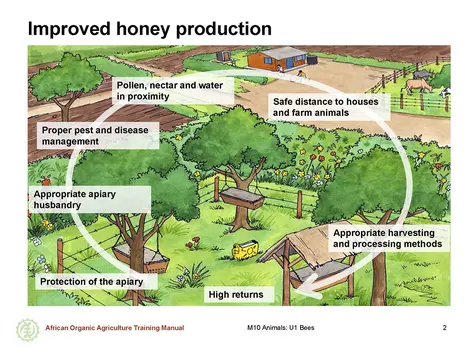
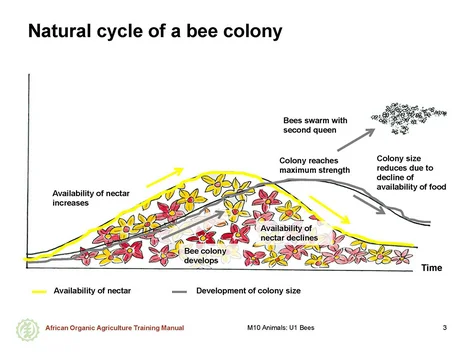
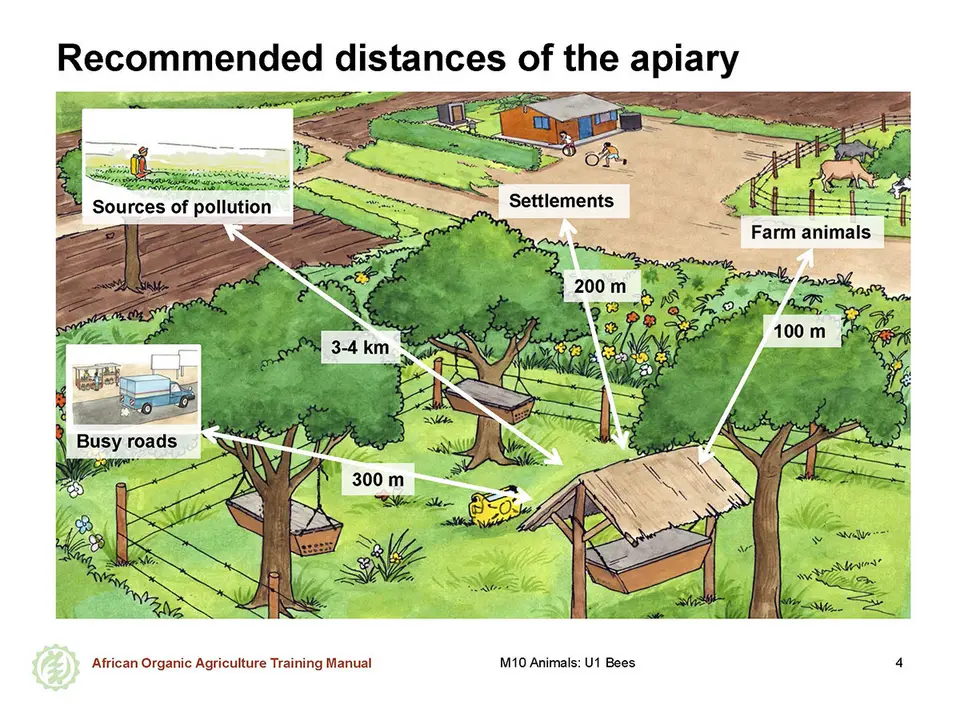
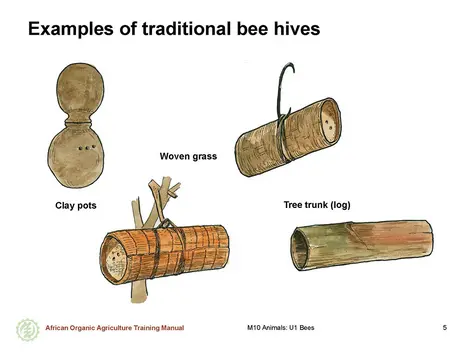
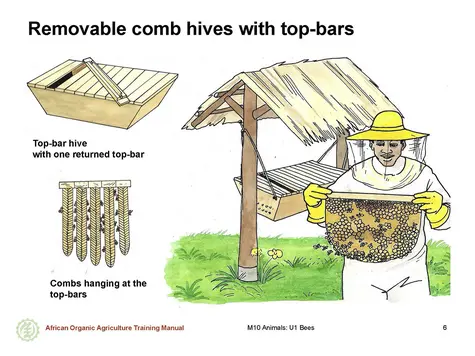
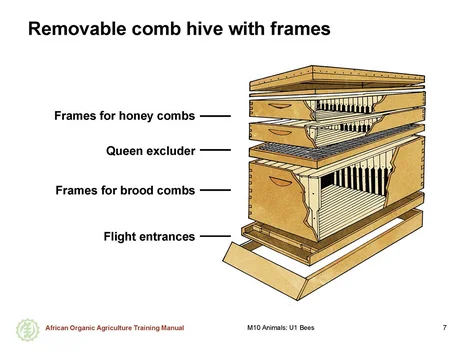
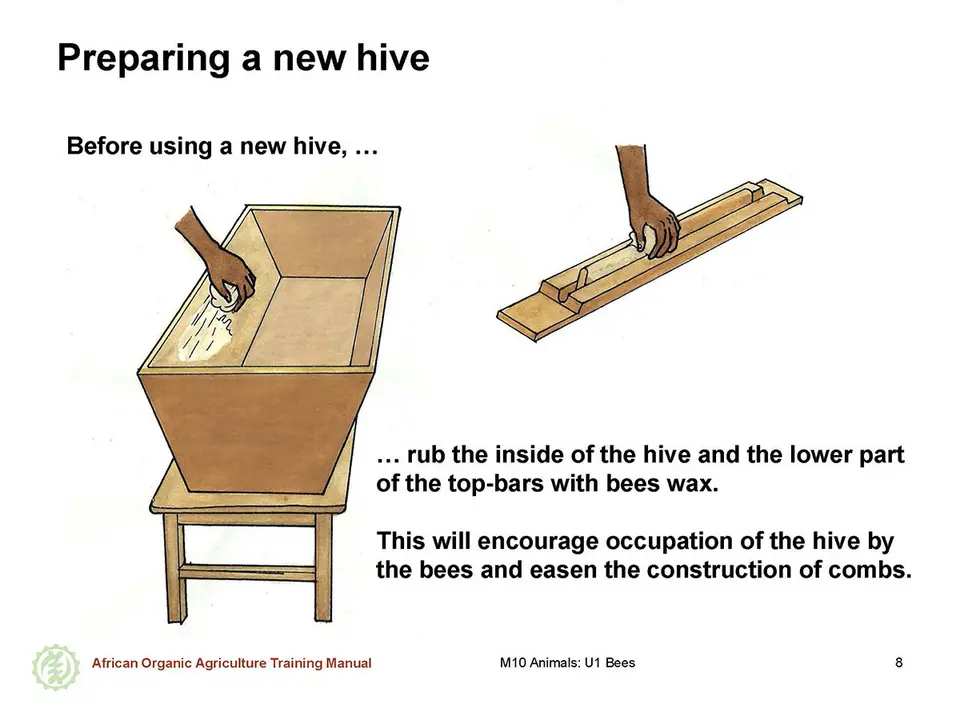
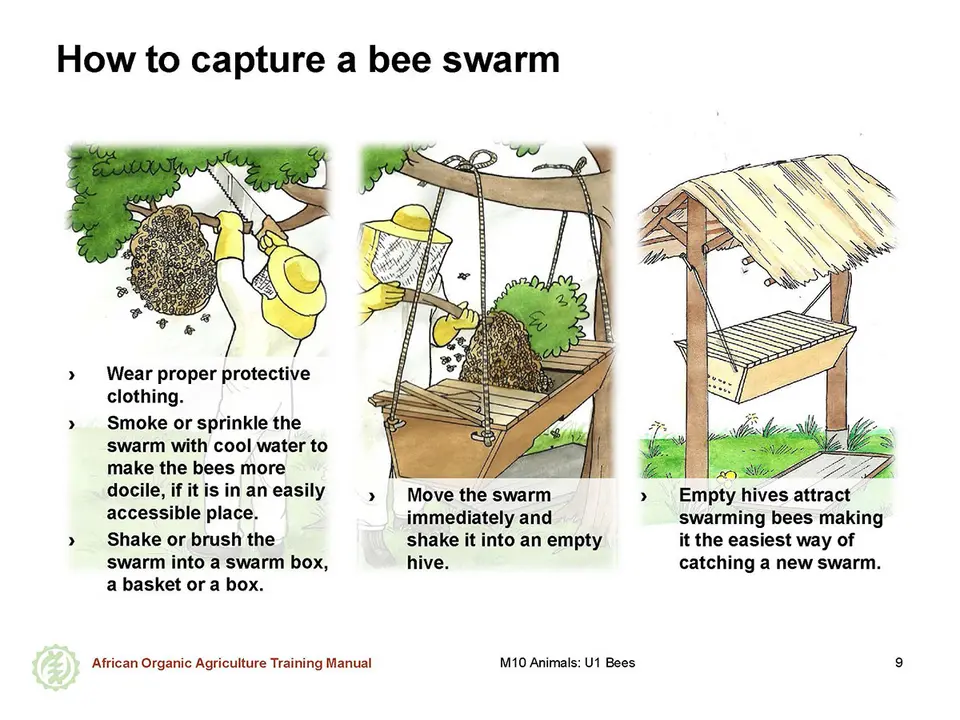
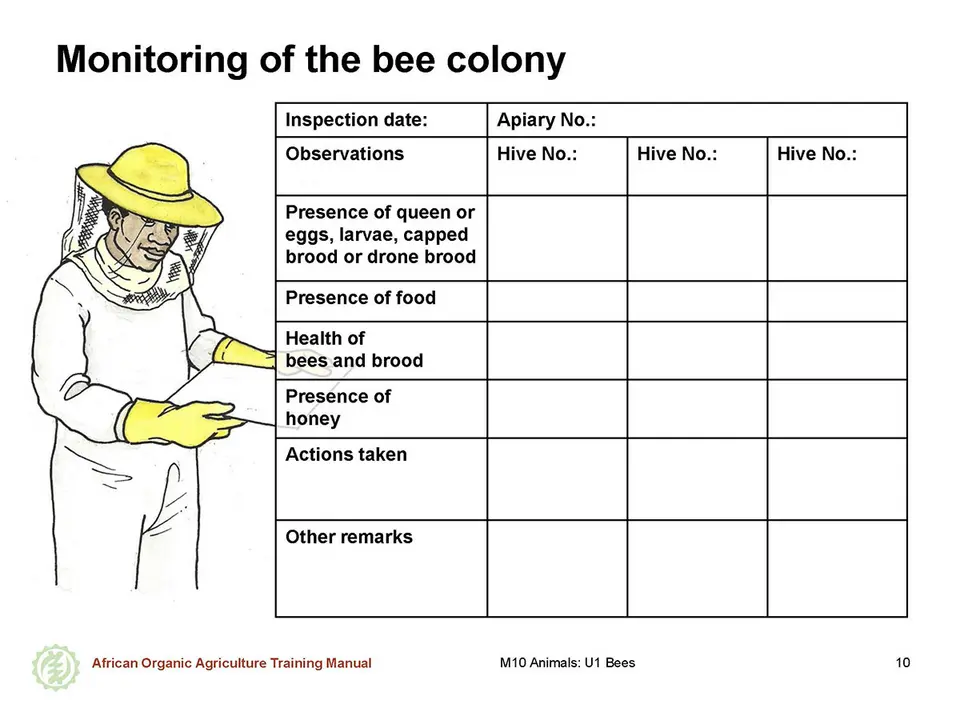
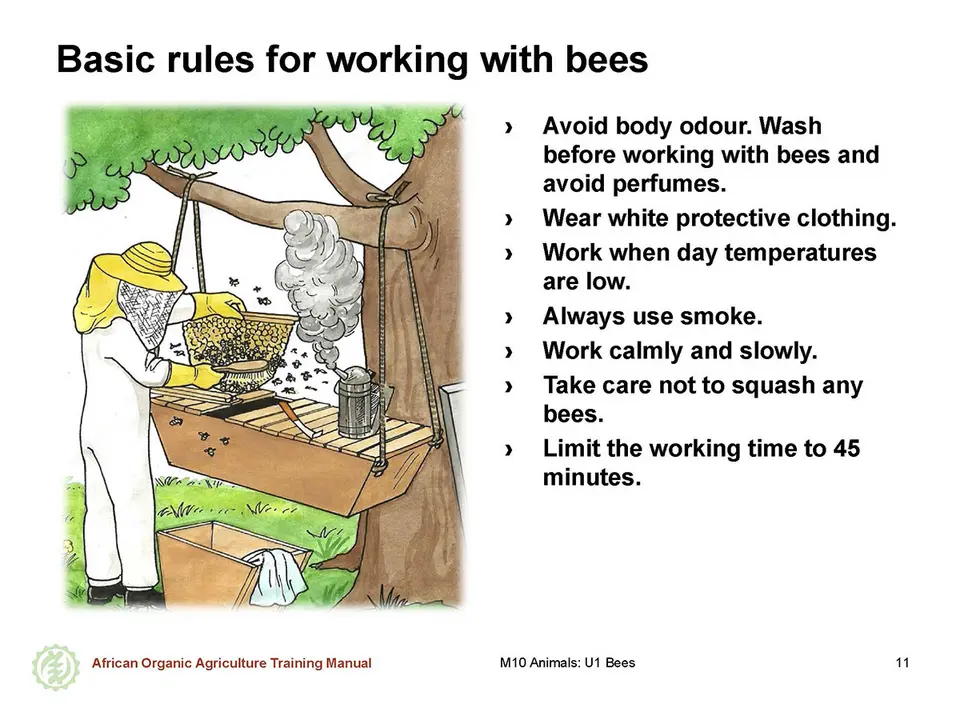
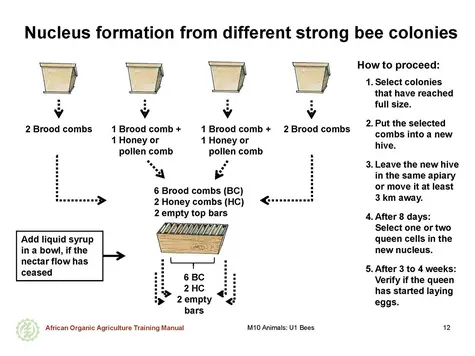
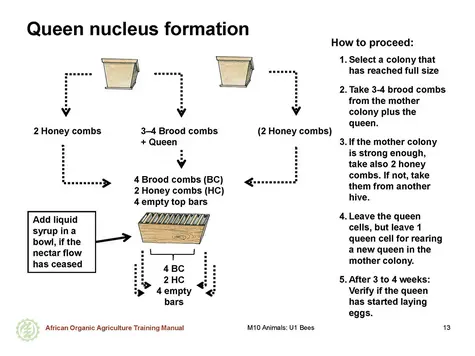
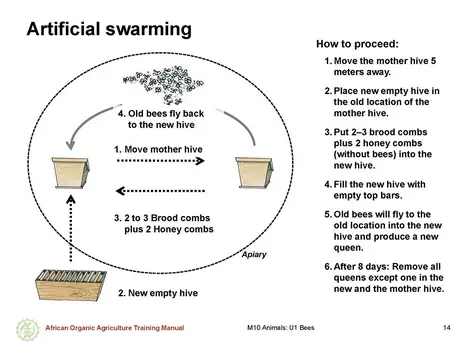
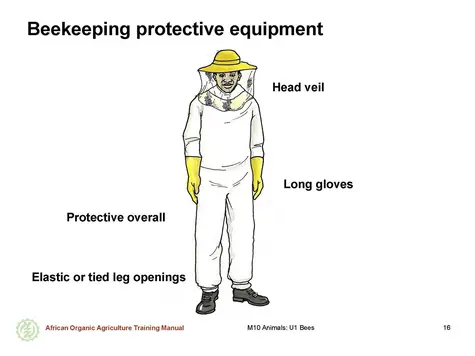
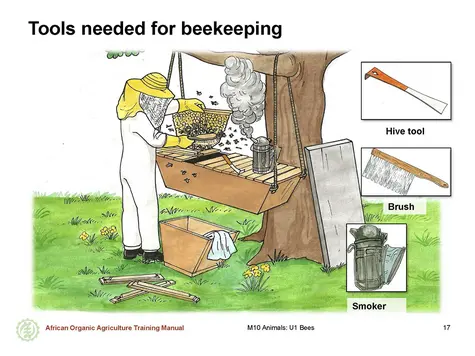
 tap and then scroll down to the Add to Home Screen command.
tap and then scroll down to the Add to Home Screen command.